Xiaohan Zhang
Carl Zeiss Meditec AG
Recurrent Cross-View Object Geo-Localization
Sep 16, 2025Abstract:Cross-view object geo-localization (CVOGL) aims to determine the location of a specific object in high-resolution satellite imagery given a query image with a point prompt. Existing approaches treat CVOGL as a one-shot detection task, directly regressing object locations from cross-view information aggregation, but they are vulnerable to feature noise and lack mechanisms for error correction. In this paper, we propose ReCOT, a Recurrent Cross-view Object geo-localization Transformer, which reformulates CVOGL as a recurrent localization task. ReCOT introduces a set of learnable tokens that encode task-specific intent from the query image and prompt embeddings, and iteratively attend to the reference features to refine the predicted location. To enhance this recurrent process, we incorporate two complementary modules: (1) a SAM-based knowledge distillation strategy that transfers segmentation priors from the Segment Anything Model (SAM) to provide clearer semantic guidance without additional inference cost, and (2) a Reference Feature Enhancement Module (RFEM) that introduces a hierarchical attention to emphasize object-relevant regions in the reference features. Extensive experiments on standard CVOGL benchmarks demonstrate that ReCOT achieves state-of-the-art (SOTA) performance while reducing parameters by 60% compared to previous SOTA approaches.
MASteer: Multi-Agent Adaptive Steer Strategy for End-to-End LLM Trustworthiness Repair
Aug 09, 2025Abstract:Large Language Models (LLMs) face persistent and evolving trustworthiness issues, motivating developers to seek automated and flexible repair methods that enable convenient deployment across diverse scenarios. Existing repair methods like supervised fine-tuning (SFT) and reinforcement learning with human feedback (RLHF) are costly and slow, while prompt engineering lacks robustness and scalability. Representation engineering, which steers model behavior by injecting targeted concept vectors during inference, offers a lightweight, training-free alternative. However, current approaches depend on manually crafted samples and fixed steering strategies, limiting automation and adaptability. To overcome these challenges, we propose MASteer, the first end-to-end framework for trustworthiness repair in LLMs based on representation engineering. MASteer integrates two core components: AutoTester, a multi-agent system that generates diverse, high-quality steer samples tailored to developer needs; and AutoRepairer, which constructs adaptive steering strategies with anchor vectors for automated, context-aware strategy selection during inference. Experiments on standard and customized trustworthiness tasks show MASteer consistently outperforms baselines, improving metrics by 15.36% on LLaMA-3.1-8B-Chat and 4.21% on Qwen-3-8B-Chat, while maintaining general model capabilities. MASteer demonstrates strong robustness, generalization, and practical value for scalable, efficient trustworthiness repair.
GLM-4.5: Agentic, Reasoning, and Coding (ARC) Foundation Models
Aug 08, 2025Abstract:We present GLM-4.5, an open-source Mixture-of-Experts (MoE) large language model with 355B total parameters and 32B activated parameters, featuring a hybrid reasoning method that supports both thinking and direct response modes. Through multi-stage training on 23T tokens and comprehensive post-training with expert model iteration and reinforcement learning, GLM-4.5 achieves strong performance across agentic, reasoning, and coding (ARC) tasks, scoring 70.1% on TAU-Bench, 91.0% on AIME 24, and 64.2% on SWE-bench Verified. With much fewer parameters than several competitors, GLM-4.5 ranks 3rd overall among all evaluated models and 2nd on agentic benchmarks. We release both GLM-4.5 (355B parameters) and a compact version, GLM-4.5-Air (106B parameters), to advance research in reasoning and agentic AI systems. Code, models, and more information are available at https://github.com/zai-org/GLM-4.5.
Beyond Uniform Criteria: Scenario-Adaptive Multi-Dimensional Jailbreak Evaluation
Aug 08, 2025Abstract:Precise jailbreak evaluation is vital for LLM red teaming and jailbreak research. Current approaches employ binary classification ( e.g., string matching, toxic text classifiers, LLM-driven methods), yielding only "yes/no" labels without quantifying harm intensity. Existing multi-dimensional frameworks ( e.g., Security Violation, Relative Truthfulness, Informativeness) apply uniform evaluation criteria across scenarios, resulting in scenario-specific mismatches--for instance, "Relative Truthfulness" is irrelevant to "hate speech"--which compromise evaluation precision. To tackle these limitations, we introduce SceneJailEval, with key contributions: (1) A groundbreaking scenario-adaptive multi-dimensional framework for jailbreak evaluation, overcoming the critical "one-size-fits-all" constraint of existing multi-dimensional methods, and featuring strong extensibility to flexibly adapt to customized or emerging scenarios. (2) A comprehensive 14-scenario dataset with diverse jailbreak variants and regional cases, filling the long-standing gap in high-quality, holistic benchmarks for scenario-adaptive evaluation. (3) SceneJailEval achieves state-of-the-art results, with an F1 score of 0.917 on our full-scenario dataset (+6% over prior SOTA) and 0.995 on JBB (+3% over prior SOTA), surpassing accuracy limits of existing evaluation methods in heterogeneous scenarios and confirming its advantage.
Benchmarking Multimodal LLMs on Recognition and Understanding over Chemical Tables
Jun 13, 2025Abstract:Chemical tables encode complex experimental knowledge through symbolic expressions, structured variables, and embedded molecular graphics. Existing benchmarks largely overlook this multimodal and domain-specific complexity, limiting the ability of multimodal large language models to support scientific understanding in chemistry. In this work, we introduce ChemTable, a large-scale benchmark of real-world chemical tables curated from the experimental sections of literature. ChemTable includes expert-annotated cell polygons, logical layouts, and domain-specific labels, including reagents, catalysts, yields, and graphical components and supports two core tasks: (1) Table Recognition, covering structure parsing and content extraction; and (2) Table Understanding, encompassing both descriptive and reasoning-oriented question answering grounded in table structure and domain semantics. We evaluated a range of representative multimodal models, including both open-source and closed-source models, on ChemTable and reported a series of findings with practical and conceptual insights. Although models show reasonable performance on basic layout parsing, they exhibit substantial limitations on both descriptive and inferential QA tasks compared to human performance, and we observe significant performance gaps between open-source and closed-source models across multiple dimensions. These results underscore the challenges of chemistry-aware table understanding and position ChemTable as a rigorous and realistic benchmark for advancing scientific reasoning.
TraGraph-GS: Trajectory Graph-based Gaussian Splatting for Arbitrary Large-Scale Scene Rendering
Jun 10, 2025Abstract:High-quality novel view synthesis for large-scale scenes presents a challenging dilemma in 3D computer vision. Existing methods typically partition large scenes into multiple regions, reconstruct a 3D representation using Gaussian splatting for each region, and eventually merge them for novel view rendering. They can accurately render specific scenes, yet they do not generalize effectively for two reasons: (1) rigid spatial partition techniques struggle with arbitrary camera trajectories, and (2) the merging of regions results in Gaussian overlap to distort texture details. To address these challenges, we propose TraGraph-GS, leveraging a trajectory graph to enable high-precision rendering for arbitrarily large-scale scenes. We present a spatial partitioning method for large-scale scenes based on graphs, which incorporates a regularization constraint to enhance the rendering of textures and distant objects, as well as a progressive rendering strategy to mitigate artifacts caused by Gaussian overlap. Experimental results demonstrate its superior performance both on four aerial and four ground datasets and highlight its remarkable efficiency: our method achieves an average improvement of 1.86 dB in PSNR on aerial datasets and 1.62 dB on ground datasets compared to state-of-the-art approaches.
CDFormer: Cross-Domain Few-Shot Object Detection Transformer Against Feature Confusion
May 02, 2025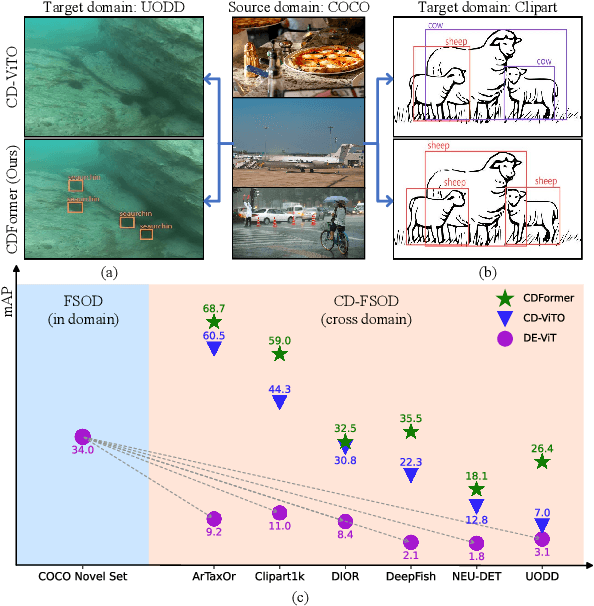
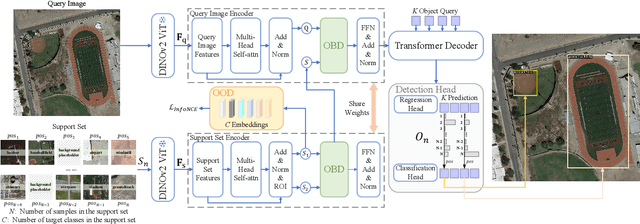

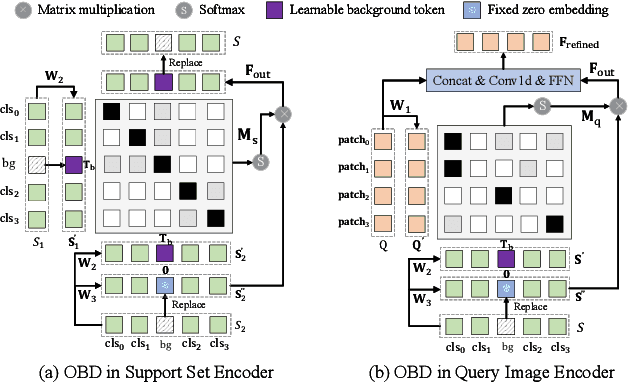
Abstract:Cross-domain few-shot object detection (CD-FSOD) aims to detect novel objects across different domains with limited class instances. Feature confusion, including object-background confusion and object-object confusion, presents significant challenges in both cross-domain and few-shot settings. In this work, we introduce CDFormer, a cross-domain few-shot object detection transformer against feature confusion, to address these challenges. The method specifically tackles feature confusion through two key modules: object-background distinguishing (OBD) and object-object distinguishing (OOD). The OBD module leverages a learnable background token to differentiate between objects and background, while the OOD module enhances the distinction between objects of different classes. Experimental results demonstrate that CDFormer outperforms previous state-of-the-art approaches, achieving 12.9% mAP, 11.0% mAP, and 10.4% mAP improvements under the 1/5/10 shot settings, respectively, when fine-tuned.
Metamon-GS: Enhancing Representability with Variance-Guided Densification and Light Encoding
Apr 20, 2025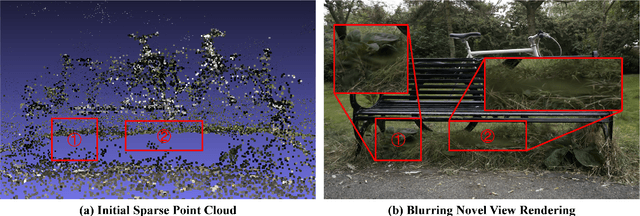

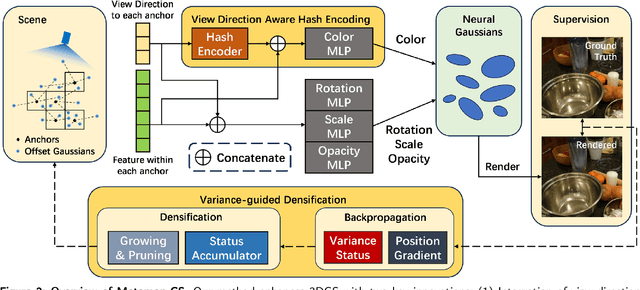

Abstract:The introduction of 3D Gaussian Splatting (3DGS) has advanced novel view synthesis by utilizing Gaussians to represent scenes. Encoding Gaussian point features with anchor embeddings has significantly enhanced the performance of newer 3DGS variants. While significant advances have been made, it is still challenging to boost rendering performance. Feature embeddings have difficulty accurately representing colors from different perspectives under varying lighting conditions, which leads to a washed-out appearance. Another reason is the lack of a proper densification strategy that prevents Gaussian point growth in thinly initialized areas, resulting in blurriness and needle-shaped artifacts. To address them, we propose Metamon-GS, from innovative viewpoints of variance-guided densification strategy and multi-level hash grid. The densification strategy guided by variance specifically targets Gaussians with high gradient variance in pixels and compensates for the importance of regions with extra Gaussians to improve reconstruction. The latter studies implicit global lighting conditions and accurately interprets color from different perspectives and feature embeddings. Our thorough experiments on publicly available datasets show that Metamon-GS surpasses its baseline model and previous versions, delivering superior quality in rendering novel views.
ComplexFuncBench: Exploring Multi-Step and Constrained Function Calling under Long-Context Scenario
Jan 17, 2025


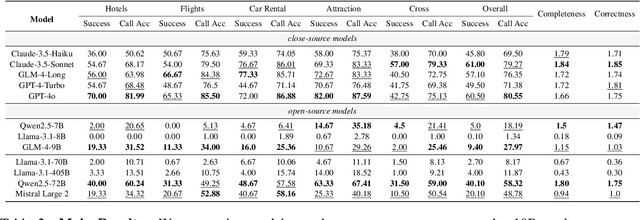
Abstract:Enhancing large language models (LLMs) with real-time APIs can help generate more accurate and up-to-date responses. However, evaluating the function calling abilities of LLMs in real-world scenarios remains under-explored due to the complexity of data collection and evaluation. In this work, we introduce ComplexFuncBench, a benchmark for complex function calling across five real-world scenarios. Compared to existing benchmarks, ComplexFuncBench encompasses multi-step and constrained function calling, which requires long-parameter filing, parameter value reasoning, and 128k long context. Additionally, we propose an automatic framework, ComplexEval, for quantitatively evaluating complex function calling tasks. Through comprehensive experiments, we demonstrate the deficiencies of state-of-the-art LLMs in function calling and suggest future directions for optimizing these capabilities. The data and code are available at \url{https://github.com/THUDM/ComplexFuncBench}.
VisionReward: Fine-Grained Multi-Dimensional Human Preference Learning for Image and Video Generation
Dec 30, 2024Abstract:We present a general strategy to aligning visual generation models -- both image and video generation -- with human preference. To start with, we build VisionReward -- a fine-grained and multi-dimensional reward model. We decompose human preferences in images and videos into multiple dimensions, each represented by a series of judgment questions, linearly weighted and summed to an interpretable and accurate score. To address the challenges of video quality assessment, we systematically analyze various dynamic features of videos, which helps VisionReward surpass VideoScore by 17.2% and achieve top performance for video preference prediction. Based on VisionReward, we develop a multi-objective preference learning algorithm that effectively addresses the issue of confounding factors within preference data. Our approach significantly outperforms existing image and video scoring methods on both machine metrics and human evaluation. All code and datasets are provided at https://github.com/THUDM/VisionReward.
 Add to Chrome
Add to Chrome Add to Firefox
Add to Firefox Add to Edge
Add to Edge